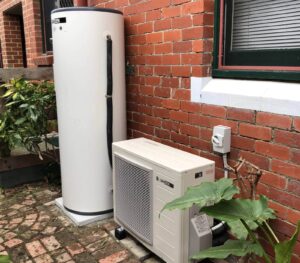Natural vs. Synthetic Refrigerants in Heat Pumps: What Is Better?
No-one’s arguing: in the age of the all-electric home and business, heat pumps stand out as versatile devices that play a pivotal role in transferring the sustainability potential of your build.
These incredible, contemporary gadgets are not only used for energy-efficient space heating and cooling but also find trusted applications in hot water systems, making them a key player in the all-electric home.
As Victoria continues to grapple with the urgency of complete and considered environmental sustainability, the choice of refrigerants in heat pumps becomes a critical decision.
But why does it matter?
Let’s start with the basics.
What is a Heat Pump?
You’ve heard us describe it this way before. A heat pump essentially acts as a reverse refrigerator, extracting heat from the surrounding environment and releasing it into whatever system that requires heating (and/or cooling).
Unlike air-conditioners and refrigerators, heat pumps can be configured to provide both heating and cooling (depending on the type of hot water or HVAC system you choose), making them adaptable to diverse needs around home and business.
In Victoria, where the climate varies across the landscape, heat pumps enjoy handy applications in residential, commercial, and industrial settings, offering a diverse range of energy-efficient solutions for space heating/cooling and hot water.
What is Refrigerant and How Does it Work in a Heat Pump?
At the heart of a heat pump’s functionality lies the refrigerant, a substance crucial for transporting heat within the system.
The refrigerant undergoes a cycle involving four main components: evaporator, compressor, condenser, and expansion valve. In the evaporator, heat is absorbed from the environment, causing the refrigerant to transform into gas. The system’s compressor then pressurises the gas, sending it to the condenser, where it releases heat into the system and condenses back into liquid.
Finally, the expansion valve completes the cycle by regulating the flow of the refrigerant back to the evaporator.
What heat pump refrigerant options do I have?
Over the last few years and decades, many synthetic refrigerants where phased out of use in the international market due to their impact on the environment, including the ozone layer.
With many more natural and sustainable options now available on the market, the battle between natural and synthetic refrigerants unfolds with a few main types of natural refrigerants taking the stage.
Here are some popular options:
- Ammonia (NH3): This colourless gas, known for its pungent odour, finds use in industrial and large-scale commercial refrigeration systems.
- Carbon Dioxide (CO2): A colourless, odourless gas used in various refrigeration systems, including hot water heat pumps, CO2 is gaining popularity for its eco-friendly properties.
- Hydrocarbons (propane, butane, isobutane): Naturally occurring gases utilised in small refrigeration and air conditioning systems, as well as hot water heat pumps in domestic and small commercial settings.
- Water: Employed as a refrigerant in absorption refrigeration systems, primarily in large-scale industrial applications.
Put simply, another reason why customers are opting for natural refrigerants is simply because including a synthetic, environmentally concerning substance at the core of your heat pump seems counterintuitive to its cause.
The shift towards natural refrigerants gains momentum as companies and governments strive to reduce environmental impact and meet climate change targets. What’s more, the eco-friendly nature of these natural refrigerant options sets them apart from their synthetic counterparts, notorious for their contribution to global warming.
Understanding refrigerant GWP and PFAS
Global Warming Potential (GWP) serves as a metric to gauge the impact of greenhouse gases across the solar sector. Generally, the higher the GWP, the more potent the gas is in contributing to global warming.
For example, Polyfluoroalkyl Substances (PFAS), man-made chemicals associated with various health risks, have raised concerns, especially in refrigerants.
While some hot water heat pumps in Australia still utilise problematic refrigerants like HFC-134A and HFC-410A, the emphasis on natural refrigerants becomes a critical consideration for environmentally conscious consumers.
Which heat pump has the best refrigerant?
Two notable examples sold by G Store include heat pumps by Reclaim and Apricus.
- Reclaim Energy heat pump: Harnessing the power of natural refrigerant CO2, this heat pump exemplifies the utilisation of a natural refrigerant for one of the market’s most efficient hot water solutions.
- iStore heat pump: The iStore uses R134a refrigerant gas, R-134a is a very safe refrigerant with an ASHRAE safety classification of A1. This means it is not flammable and has very low toxicity levels.
Keen to learn more about the other heat pumps (including the amazing Sanden heat pumps and Stiebel Eltron heat pumps we proudly stock, sell and recommend at G Store? Our contact details are below – we’d love to hear from you!
Wrapping up
Looking for more info on heat pump refrigerant and the best heat pumps available in Victoria, plus the brands and models we stock and recommend at G Store?
Visit our Learning Centre today, or give our award-winning G Store team a call today on 1300 137 567 for free, generous advice regarding all of your questions.
We can’t wait to speak with you!



Get in touch
Ready for your obligation-free consultation call?
Give our friendly team a call today on 1300 137 567. We can’t wait to meet you
1300 137 567
Send us a message